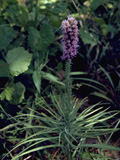
Dense flower spikes attract numerous bees, butterflies, and moths, including the pink bleeding flower moth (Schinia sanguinea).
The stems of this showy perennial are 2-5 ft. tall, and nearly half of this is the flower spike. A spike of rayless, rose-purple (rarely white), cylindrical, stalkless flower heads densely crowded on a coarse, hairy, very leafy stem. Stamens and styles protrude from the purple, tufted flower heads, creating a fuzzy appearance. Flowers bloom from the top of the spike downward. The lower portion of the stem is covered with short, fuzzy, grass-like leaves.
One of the most popular of the blazing stars, this is sometimes grown as an ornamental. The species name, from the Greek for crowded, describes both the leaves and the flower heads. A species found in dry prairies, Dotted Blazing Star (L. punctata), has leaves covered with resinous dots and long, pointed, flat bracts beneath the flower heads.
More from USDA Plants Database »